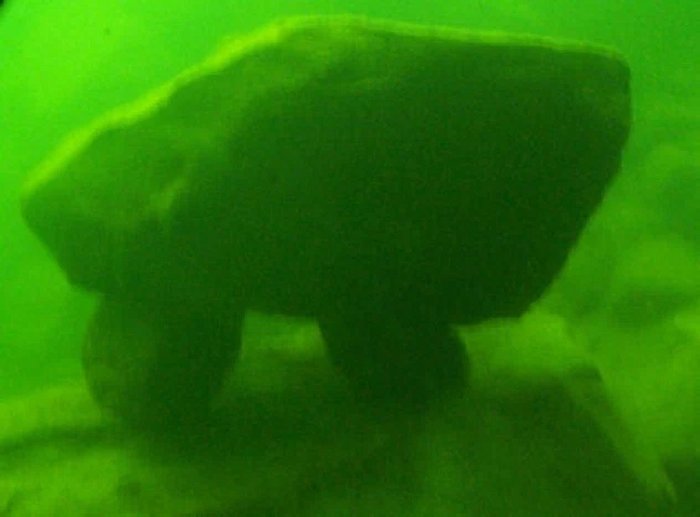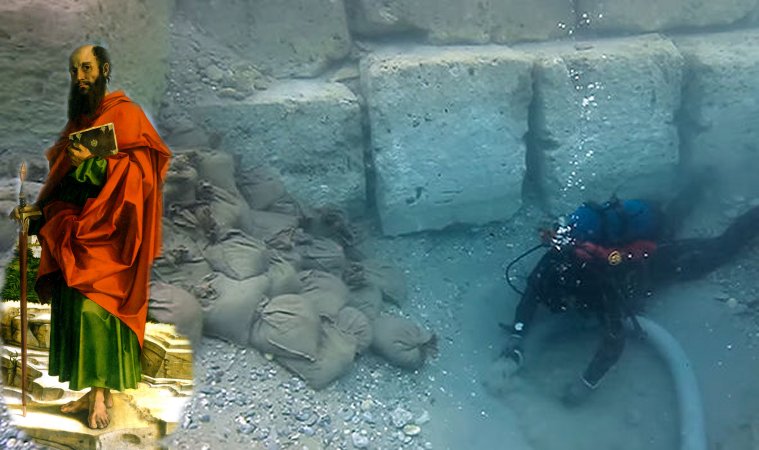10 Enigmatic Ancient Underwater Ruins – Our Oceans Are Full Of Secrets
Conny Waters - AncientPages.com - Our oceans are greatly unexplored and full of secrets. Deep beneath the waters there are marvelous ruins of lost ancient civilizations.
These ancient underwater remains serve as a reminder of how vulnerable we are and how fast Mother Nature can end our existence.
To date, it is estimated that we have explored only 3 to 5 percent of the ocean floor. With so much territory still left to explore, we can only imagine the discoveries yet to come! Here are just a few examples of remarkable ancient underwater discoveries.
1. Dwaraka - Lord Krishna's Lost City
For a long time, Krishna's legendary city of Dwaraka was considered to be nothing but a myth.
However, not so long ago a group of Indian scientists accidentally discovered the lost city of Dwaraka, submerged off the north western coast of India near the Gulf of Cambay or Khambat.
After so many years it turned out that the 12,000 year old city of Dwaraka was not a myth at all, but a real place that existed in the distant past.
"The sea, which had been beating against the shores, suddenly broke the boundary that was imposed on it by nature. The sea rushed into the city. It coursed through the streets of the beautiful city.
The sea covered up everything in the city. I saw the beautiful buildings becoming submerged one by one. In a matter of a few moments it was all over.
The sea had now become as placid as a lake. There was no trace of the city. Dwaraka was just a name; just a memory..." – Mahabharata - Read more about Dwarka
2. Lost Kingdom Of Cleopatra
Lost for 1,600 years, the kingdom of Cleopatra was discovered off the shores of Alexandria, Egypt.
Cleopatra VII Philopator, known to history as Cleopatra, was the last pharaoh of Ancient Egypt.
She was a member of the Ptolemaic dynasty, a family of Greek origin that ruled Egypt after Alexander the Great's death during the Hellenistic period.
It is commonly believed that the Cleopatra's empire was destroyed by an earthquake and tidal waves
Scientists think that the entire city was completely submerged, along with all the artifacts, statues, columns and other beauties of the palace of Cleopatra. Read more here
3. Lost Continent Of Mu - 8000-Year-Old Yonaguni-Jima Ruins
In 1987, while looking for good under-water sites to dive near Yonaguni, scuba diving instructor Kihachiro Aratake, discovered an amazing under-water construct 20 feet below the surface of the water. The construct is defined as being "as if terraced into the side of a mountain," resembling a grand stand for Sea Gods, or somewhat like an amphitheater with its huge steps and blocks of stone.
The construct's 250-foot base lies 100 feet below the ocean's surface and rises to a height of 80 feet. The Monument consists of medium to very fine sandstones and mudstones of the Lower Miocene Yaeyama Group believed to have been deposited about 20 million years ago.
The underwater formation or ruin called "The Turtle" at Yonaguni, Ryukyu Islands. Image credit: Masahiro Kaji - The Japan's Dive-spot Gallery
It has been debated whether the site is completely natural, is a natural site that has been modified, or is a manmade artifact. Some researchers believe the underwater ruins near Yonaguni are part of the legendary lost continent of Mu.
4. Wickedest City On Earth
Once known as the "Wickedest City on Earth" for its sheer concentration of pirates, prostitutes and rum, Port Royal is now famous for another reason: "It is the only sunk city in the New World," according to Donny L. Hamilton.
In 1981, the Nautical Archaeology Program of Texas A&M University, in cooperation with the Institute of Nautical Archaeology (INA) and the Jamaica National Heritage Trust (JNHT), began underwater archaeological investigations of the submerged portion of the 17th-century town of Port Royal, Jamaica. Present evidence indicates that while the areas of Port Royal that lay along the edge of the harbor slid and jumbled as they sank, destroying most of the archaeological context, the area investigated by TAMU / INA, located some distance from the harbor, sank vertically, with minimal horizontal disturbance.
In contrast to many archaeological sites, the investigation of Port Royal yielded much more than simply trash and discarded items. An unusually large amount of perishable, organic artifacts were recovered, preserved in the oxygen-depleted underwater environment.
Together with the vast treasury of complimentary historical documents, the underwater excavations of Port Royal have allowed for a detailed reconstruction of everyday life in an English colonial port city of the late 17th century. More here:
5. Pavlopetri - Unique Underwater City
The city of Pavlopetri, underwater off the coast of southern Laconia in Greece, is about 5000 years old. This underwater site is unique. An entire town is resting underwater, including streets, buildings, courtyards, and tombs. It has at least 15 buildings submerged in three to four meters of water.
Pavlopetri was presumably once a thriving harbour town where the inhabitants conducted local and long distance trade throughout the Mediterranean - its sandy and well-protected bay would have been ideal for beaching Bronze Age ships. As such the site offers major new insights into the workings of Mycenaean society.
It was discovered in 1967 by Nicholas Flemming and mapped in 1968 by a team of archaeologists from Cambridge. Read more here
6. Sunken Ancient Roman City Of Baiae With All Its Streets Imperial Villas And Statues
Ancient sunken city of Baiae is located just 30 minutes northwest of Naples.
Baiae was one of the most important cities of Ancient Rome and Roman seaside resort, overlooking the Bay of Naples. It was a place where rich Romans and emperors spent their leisure time in their luxurious villas clustered in terraces all around the bay near Naples.
A city of Baiae - named after Baios, Odysseus' helmsman - was connected to the Roman Empire’s biggest naval base, Portus Julius, home port of the western Imperial Fleet of ancient Rome. Read more here
7. Ancient Underwater 'Lion City'
There are many secrets deep beneath the waters, but it is not often we report about ancient cities that are deliberately submerged. Hidden 130 feet underwater beneath the Qiandao lake (Thousand Island Lake), between the Five Lion Mountain, in the eastern province of Zhejiang is the so-called Lion City, or "Shi Cheng" in Mandarin.
The city was as built in the Later Han dynasty in 208 AD. The city remains undisturbed from the surface at a depth of 26-40m, and has provided scientists and archaeologists a glimpse into what life in ancient China was really like.
Many of the intricate stone carvings and guardian lions that were scattered around the city are still perfectly intact. Read more here
8. Mysterious Ancient Underwater Structure Beneath MacDonald Lake Reveals Traces Of A Lost Civilization In Ontario
A mysterious ancient underwater structure hidden beneath MacDonald Lake reveals traces of a lost civilization present in Ontario, Canada thousands of years ago. Who were these people? Where did they come from and what happened to them? The discovery raises a number of unanswered questions.
The discovery was made by divers participating in unique submarine project at the acclaimed Haliburton Forest and Wild Life Reserve. Haliburton Forest is a premiere Ontario attraction, well known for its commitment to education, wildlife and the environment.
At first divers who examined the puzzling underwater structure thought it was a geological formation, but later studies it was a manmade object. The puzzling stone structure was found at a depth of 40 feet (12 m) below the surface. It consists of a massive 1,000 lb (453 kg) elongated rock with an almost completely level surface resting on 7 baseball-sized stones, which in turn sits on a huge several thousand pound slab on top of a ledge.
Geologists and archaeologists were puzzled by ancient structure’s straight edges and lack of roundness. It seemed the stone could not be one of the rocks scoured by glaciers. Read more
9. Remarkable Man-Made Underwater Structures Could Rewrite History Of Wisconsin
All across the world there are many underwater structures that still remain unexplored. Beneath the waters of our oceans and lakes lie sunken buildings, roads, entire cities, pyramids and artifacts belonging to long lost and forgotten civilizations.
Why have these submerged ruins not been properly investigated?
There are remarkable, artificial underwater structures beneath the waters of Rock Lake, Wisconsin but unfortunately for many years these prehistoric ruins have been ignored by researchers. Read more
10. Ruins Of Biblical City Of Corinth Discovered Underwater – Giant Monuments and Remains Of Lighthouse Still Well-Preserved
Archaeologists have discovered ruins of the lost town of Lechaion, the harbor from the ancient Greek city of Corinth.
Many of the ancient underwater ruins are extremely well-preserved and among the monuments built of 5 ton blocks there are even remains of an ancient lighthouse which was depicted on coins from that time.
For Christians, the ancient Greek city of Corinth holds Biblical significance as two letters from Jesus' disciple Paul feature in the Bible's New Testament – the books of 1 Corinthians and 2 Corinthians.
According to the Christian Bible, Paul is also said to have visited the ancient city while it was under Roman rule. Read more
More From Ancient Pages
-
 Dwarka – Pre-Harappan City That Could Rewrite The History Of The World
Civilizations | Aug 19, 2014
Dwarka – Pre-Harappan City That Could Rewrite The History Of The World
Civilizations | Aug 19, 2014 -
 5th-Century Tomb With Finds Of Historical And Artistic Value Discovered In Eastern Bohemia
Archaeology | Mar 8, 2021
5th-Century Tomb With Finds Of Historical And Artistic Value Discovered In Eastern Bohemia
Archaeology | Mar 8, 2021 -
 Huge Ancient Sarayini Underground City Is Twice As Large As Previously Thought
Archaeology | Aug 22, 2023
Huge Ancient Sarayini Underground City Is Twice As Large As Previously Thought
Archaeology | Aug 22, 2023 -
 DNA Study Sheds New Light On Ancient Britain’s Language, Ancestry, Kinship, Milk
Archaeology | Dec 26, 2021
DNA Study Sheds New Light On Ancient Britain’s Language, Ancestry, Kinship, Milk
Archaeology | Dec 26, 2021 -
 Why The Aztecs Called Themselves ‘Mexica’
Ancient History Facts | Jan 13, 2018
Why The Aztecs Called Themselves ‘Mexica’
Ancient History Facts | Jan 13, 2018 -
 Secrets Of Neanderthals’ 130,000-Year-Old Carved Bear Bone Found In The Carpathian Mountains
Archaeology | May 24, 2024
Secrets Of Neanderthals’ 130,000-Year-Old Carved Bear Bone Found In The Carpathian Mountains
Archaeology | May 24, 2024 -
 Was Napoleon Bonaparte Defeated At Waterloo Because Of Volcanic Eruption?
Archaeology | Aug 22, 2018
Was Napoleon Bonaparte Defeated At Waterloo Because Of Volcanic Eruption?
Archaeology | Aug 22, 2018 -
 Khufu Boat And Unique Boat-Building Technique Of Ancient Egyptians
Artifacts | Jun 20, 2017
Khufu Boat And Unique Boat-Building Technique Of Ancient Egyptians
Artifacts | Jun 20, 2017 -
 Hundreds Of 19th-Century Skulls Collected In The Name Of Medical Science Tell A Story Of Who Mattered And Who Didn’t
Featured Stories | Nov 14, 2024
Hundreds Of 19th-Century Skulls Collected In The Name Of Medical Science Tell A Story Of Who Mattered And Who Didn’t
Featured Stories | Nov 14, 2024 -
 3,000-Year-Old Settlement Studied By Archaeologists In Cyprus
Archaeology | Sep 10, 2022
3,000-Year-Old Settlement Studied By Archaeologists In Cyprus
Archaeology | Sep 10, 2022 -
 Mysterious 2000-Year-Old Carved Vishap Stone Monuments Of Armenia
Featured Stories | Dec 13, 2016
Mysterious 2000-Year-Old Carved Vishap Stone Monuments Of Armenia
Featured Stories | Dec 13, 2016 -
 Early Humans May Have First Walked Upright In The Trees 7 Million Years Ago
Human Beginnings | Dec 17, 2022
Early Humans May Have First Walked Upright In The Trees 7 Million Years Ago
Human Beginnings | Dec 17, 2022 -
 Lost Kingdom Of Cleopatra – Legendary Lost City Of Heracleion
Featured Stories | Apr 1, 2014
Lost Kingdom Of Cleopatra – Legendary Lost City Of Heracleion
Featured Stories | Apr 1, 2014 -
 Spectacular Ancient Underground ‘Stonehenge’ Dolmen De Soto Reveals Its Secrets
Archaeology | Apr 18, 2019
Spectacular Ancient Underground ‘Stonehenge’ Dolmen De Soto Reveals Its Secrets
Archaeology | Apr 18, 2019 -
 How Did Climate Change Impact European Ice Age Humans?
Earth Changes | Aug 21, 2024
How Did Climate Change Impact European Ice Age Humans?
Earth Changes | Aug 21, 2024 -
 Gothic Warrior With Rare Sword Unearthed In Thessaloniki, Greece
Archaeology | Apr 23, 2021
Gothic Warrior With Rare Sword Unearthed In Thessaloniki, Greece
Archaeology | Apr 23, 2021 -
 5 Different Types Of Priests In Ancient Rome – Their Role And Responsibility Explained
Ancient History Facts | Jan 30, 2018
5 Different Types Of Priests In Ancient Rome – Their Role And Responsibility Explained
Ancient History Facts | Jan 30, 2018 -
 Ancient Humans Were So Good At Surviving The Last Ice Age They Didn’t Have To Migrate Like Other Species – New Study
Featured Stories | Oct 16, 2024
Ancient Humans Were So Good At Surviving The Last Ice Age They Didn’t Have To Migrate Like Other Species – New Study
Featured Stories | Oct 16, 2024 -
 Cooking, Roasting And Eating Of Root Plants Is 120,000-Year-Old Habit
Archaeology | Jun 7, 2019
Cooking, Roasting And Eating Of Root Plants Is 120,000-Year-Old Habit
Archaeology | Jun 7, 2019 -
 Discovery Of Roman Settlement, Workshops And Artifacts Will Shed Light On Their Life In Northern England
Archaeology | Apr 13, 2017
Discovery Of Roman Settlement, Workshops And Artifacts Will Shed Light On Their Life In Northern England
Archaeology | Apr 13, 2017













